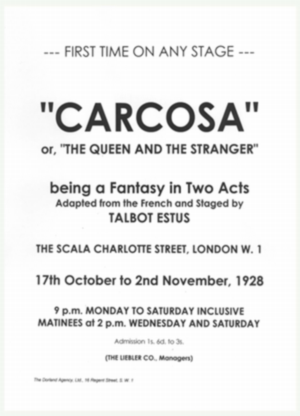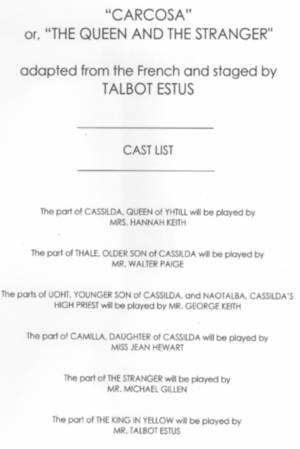Table of Contents
Carcosa, or The Queen and the Stranger
A fantasy in two acts by Talbot Estus performed by 'The Group' at the Scala Theatre on the 17th of October 1928.
Cast
- Thale, older son of Cassilda - Mr. Walter Paige
- Uoht, younger son of Cassilda and Naotalba, Cassilda's high priest - Mr. George Keith
The Story
 The main story threads of the 'Carcosa' play involve the following aspects:
The main story threads of the 'Carcosa' play involve the following aspects:
- On the far shore of Hali, when the Hyades rise, can be seen the mysterious city of Carcosa, a city with five singularities (of which four are revealed). It is said The King in Yellow rules there.
- Nothing ever happens of note in Yhtill.
- There is an endless debate about the succession between Cassilda’s two sons that seems to hinge on which one their sister Camilla chooses as her husband.
- Cassilda fears the coming of The Yellow Sign – a symbol sent from Carcosa to all Yhtillian monarchs. Its significance is unclear.
- A stranger wearing a pale mask arrives in the city, causing a great commotion.
- The stranger tells the royal family that the mask is a weapon against the King in Yellow. He reveals that he wears the Yellow Sign – and later claims he does this as a sign of its powerlessness against the Pallid Mask, but its revelation causes horror among the royal family.
- The Stranger suggests a masked ball, in which all shall wear the Pallid Mask, and thus be free forever of the influence of the King.
- During the ball, the Stranger reveals that he is a spy from Alar, and that he wears no Mask.
- At this, the King in Yellow makes his appearance, slays the Stranger and tells the people of Yhtill that Yhtill and Carcosa are now the same city, and that the price of this alliance against Alar, which will be destroyed is the ‘fixing of the Mask’ – Cassilda and her family are horrified and the King ends by asking ‘Did you think to be human still?’
Oddities at the Play
 As the mysteries surrounding the Play, and its history were uncovered by the party, they were drawn further in the madness and insanity it offers all who see The Yellow Sign.
As the mysteries surrounding the Play, and its history were uncovered by the party, they were drawn further in the madness and insanity it offers all who see The Yellow Sign.
- The play as described (which is as it was seen by the PCs) differs significantly from the script, but the performers say that they performed the script exactly as written.
- In both versions of the play large sections of exposition appear to be missing – the cause and effect relationships between various elements are a total mystery. The character of the Child, for example is very peculiar.
- At the beginning of the second act, the child delivers a speech in front of the closed curtain indicating that it is now too late for the audience and that by returning to watch the second act they have committed themselves to the consequences.
- During the play, people's reactions did not seem to be in line with what was actually happening on the stage. People would react with gasps or laughter at points where nothing appeared to elicit surprise or humour.
- Nathaniel Browne noted that in the latter part of the first act, there appeared to be something being said very subtly between the lines.
- He also noticed a couple two rows in front of him leave during this time, but the other PCs said that this event did not occur.
- The play, particularly The Yellow Sign seemed to affect the emotions of some people very strongly, whereas others were affected little, if at all. After the King's exit in the last scene, there were many people overcome with emotion (to the point of almost fomenting a riot). Nathaniel Browne cried uncontrollably, while the man next to him punched his wife in the face. Due to the uproar, the last few lines of the play were drowned out.
Reviews
Some people seem to have watched (or thought they have seen) different versions of scenes than others.
Avant-Garde Nonsense Causes a Riot - as appeared in Theatre Review
The theatre-going public of London should be thankful at the news that there are to be no more performances of “Carcosa – or the Queen and the Stranger”, a “Fantasy in two acts” which had its disastrous premiere last night at the Scala Theatre.
The play, written as a first foray into drama by popular novelist Talbot Estus, and performed by the well-regarded amateur theatre company known as ‘the Group’ was, in the opinion of this reviewer, tedious, confusing and extraordinarily pretentious. The audience seem to have agreed, and in some cases to have found its dreary demands upon their time quite intolerable, as upon the final curtain a riot broke out in the theatre, resulting in several arrests and at least one badly broken nose.
The play, for what it's worth, focussed on the royal family of an undefined alien city, their squabbles over the succession, and the arrival of a mysterious masked stranger who apparently was supposed to symbolise some concept or other. The work ‘climaxed’, if that is the word, with the ludicrous arrival of ’The King in Yellow’, a demon-king character, played (badly) by Estus himself, whose motives and significance were quite lost on the poor audience.
The cast, it must be said, did the best they could with the poor material, and special mention must be made of Hannah Keith, who in the role of Queen Cassilda managed to create a few moments of genuine interest in a sea of pointless dreariness.
There remains hope for ‘the Group’, but little for Estus. Let us hope he returns to fiction, and leaves drama for those more suited to the task.
“Carcosa” a haunting masterpiece by George Hall - reporting for On Stage
This reviewer was lucky enough to be present at the premiere of “Carcosa, or the Queen and the Stranger”, a two act play by Talbot Estus, the renowned novelist, performed by ‘the Group’ at the Scala Theatre in Charlotte Street.
Though short, and in many ways hard to describe, the play contained many momments of truly haunting beauty and deep insight into the nature of humanity and its relationship to the divine. Indeed it would not be hyperbole to say that the work contains truths so profound that they could be capable of changing ones view of life itself.
The performances, aside from the radiant Hannah Keith, as Queen Cassilda, are as good as can be expected by an amateur troupe, but they are magnified by the sheer depth and poetic vision of Estus’ script, whose vision of a city, trapped in stagnation, whose ennui is shattered by the arrival of a masked stranger, the herald of the great and terrible King In Yellow, will remain with this reviewer forever.
To quote Cassilda’s song, “songs that the Hyades shall sing, where flap the tatters of the King, must die unheard in dim Carcosa.”